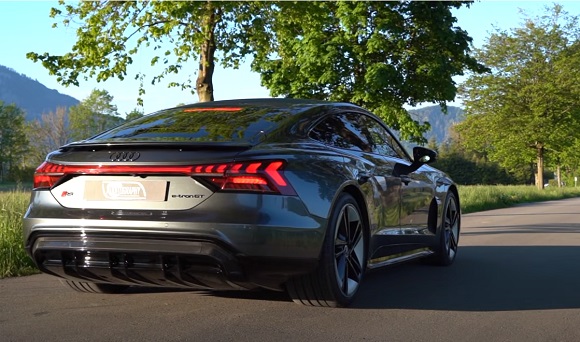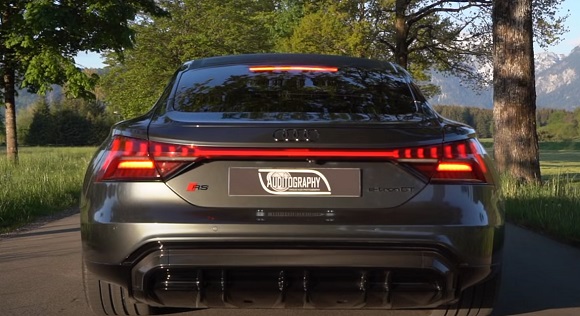
Audi RS e-tron GT 2022.
Audi RS e-tron GT 2022. The serial Audi e-tron GT electric sedan is presented in two versions.
A little over two years have passed since the debut of the Audi e-tron GT concept car, and now it has finally turned into a production car.
Moreover, on the way to the conveyor, the sedan practically did not change in appearance. It has normal door handles and large rear-view mirrors, slightly redesigned bumpers, but overall it’s still the same four-door that became the star of the Los Angeles auto show in November 2018.
Audi immodestly calls the premiere of the electric sedan the beginning of a new era in the history of the brand.
However, in reality, the e-tron GT is a «disguised» Porsche Taycan! Both models are based on the J1 platform, which is unified by the chassis elements with the Panamera, and have similar components and assemblies.
The wheelbase of the two electric vehicles is the same (2900 mm), and the overall dimensions are very close. The length of the e-tron GT sedan is 4989 mm (26 mm longer than the Taikan), width — 1964 mm (minus 2 mm), height — 1414 mm (plus 35 mm).
The electric vehicle has active air dampers for cooling the brakes, which open only when necessary. And yet the drag coefficient is 0.24 instead of 0.22 for the sister Porsche.
However, there is still room for improvement: for example, the e-tron GT is still devoid of optional cameras instead of the rear-view mirrors that the Audi e-tron crossovers have.
Despite the silhouette with a sloping roof and a short tail, the e-tron GT is precisely a sedan with frameless doors and a small trunk lid.
The volume of the compartment is 405 liters (or 366 liters if an advanced Bang & Olufsen audio system is installed). There is also a front trunk, but a modest one — only 85 liters. There are wheels with a choice of 19, 20 or 21 inches.
The sedan comes in two versions, both with two motors and four-wheel drive, although the e-tron crossover already boasts a three-engined variant.
The base Audi e-tron GT has a front engine with a peak output of 238 hp. and rear by 435 forces, and at the back, like in Taikan, a two-stage gearbox is installed.
However, it is impossible to simply add these two indicators: the total power is limited by the electronics, which can smoothly vary the load of both motors.
As a result, the maximum is 476 hp. and 630 Nm in standard mode, and if you activate the launch control, then in 2.5 seconds the recoil will grow to the same 530 hp. and 640 Nm of the Porsche Taycan 4S.
The Audi RS e-tron GT, the first electric Ereska, stands a notch higher. The front electric motor is exactly the same, while the rear one produces 456 hp.
The control principle is the same, therefore the total output in the nominal mode is 598 hp. and 830 Nm, and launch control briefly increases power to 646 hp without changing the torque. Porsche Taycan Turbo with 680 hp and 850 Nm remained unattainable.
Both versions of the Audi sedan have the same traction battery with a capacity of 93 kWh, of which 85 kWh is efficiently used.
The passport mileage on one charge according to the WLTP cycle is 487 km for the basic version and 472 km for the Ereski.
That being said, like the Taycan, the Audi sedan has an 800-volt electrical system that promises fast battery charging.
From a DC station with a power of 270 kW (this is the maximum) and a voltage of 800 volts, you can take a charge for a 100 km throw in just five minutes. A full charge will still take much longer than 25 minutes, though.
The base Audi e-tron GT can accelerate to 100 km / h in 4.1 seconds, with a top speed of 245 km / h. It has an adaptive spring suspension and a self-locking rear differential.
The Audi RS e-tron GT version has air suspension with three-chamber cylinders (the ground clearance is adjustable in the range of 42 mm) and an electronically controlled rear differential, although all this can be ordered for the initial modification.
«Eresca» can accelerate to 100 km / h in 3.3 seconds and gain 250 km / h (this is an electronic limit).
For a surcharge, both variants can be fitted with carbon-ceramic brakes and an all-wheel steering chassis.
The rear wheels can deflect a modest angle of up to 2.8 degrees, while at speeds up to 70 km / h they turn in the opposite direction with the front ones, improving maneuverability, and after 80 km / h — in the same direction, increasing stability.
It is curious that the developers have reduced the degree of futurism in the interior design: if modern Audi (the same e-tron) have a fully touch-sensitive center console, then the e-tron GT sedan has a traditional push-button climate control panel.
However, there is still nowhere without screens: the devices have a 12.3-inch display, the media system has a 10.1-inch touchscreen, and there is also a projection screen.
Among the options are adaptive cruise control (but not autopilot!), A remote-controlled parking system, matrix LED headlights and laser-phosphor high beam (turns on at speeds over 70 km / h).
And then there is the voice acting system that gives the electric car a synthesized «voice», similar to the sound of cars with internal combustion engines. Moreover, the RS version has it installed as standard.
Serial production of Audi e-tron sedans began in December at a plant in Neckarsulm, Germany, where R8 supercars and rechargeable hybrids based on the A6, A7 and A8 models are also assembled.
In Germany, orders are already open: the basic version costs 100 thousand euros, and the RS modification — 138 thousand euros. This is 6-15 thousand cheaper than similar versions of Taikan.





 Posted in
Posted in  Tags:
Tags: